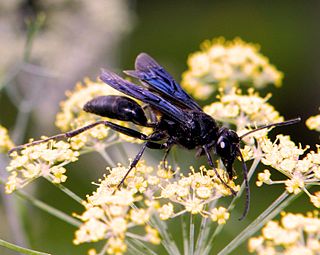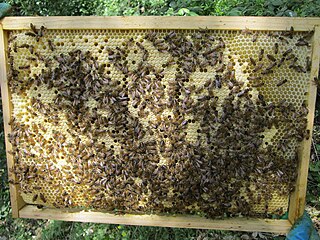
Hymenoptera is a large order of insects, comprising the sawflies, wasps, bees, and ants. Over 150,000 living species of Hymenoptera have been described, in addition to over 2,000 extinct ones. Many of the species are parasitic.

Trophallaxis is the transfer of food or other fluids among members of a community through mouth-to-mouth (stomodeal) or anus-to-mouth (proctodeal) feeding. Along with nutrients, trophallaxis can involve the transfer of molecules such as pheromones, organisms such as symbionts, and information to serve as a form of communication. Trophallaxis is used by some birds, gray wolves, vampire bats, and is most highly developed in social insects such as ants, wasps, bees, and termites.

In evolutionary ecology, a parasitoid is an organism that lives in close association with its host at the host's expense, eventually resulting in the death of the host. Parasitoidism is one of six major evolutionary strategies within parasitism, distinguished by the fatal prognosis for the host, which makes the strategy close to predation.

The Apocrita are a suborder of insects in the order Hymenoptera. It includes wasps, bees, and ants, and consists of many families. It contains the most advanced hymenopterans and is distinguished from Symphyta by the narrow "waist" (petiole) formed between the first two segments of the actual abdomen; the first abdominal segment is fused to the thorax, and is called the propodeum. Therefore, it is general practice, when discussing the body of an apocritan in a technical sense, to refer to the mesosoma and metasoma rather than the "thorax" and "abdomen", respectively. The evolution of a constricted waist was an important adaption for the parasitoid lifestyle of the ancestral apocritan, allowing more maneuverability of the female's ovipositor. The ovipositor either extends freely or is retracted, and may be developed into a stinger for both defense and paralyzing prey. Larvae are legless and blind, and either feed inside a host or in a nest cell provisioned by their mothers.

The superfamily Ichneumonoidea contains one extinct and three extant families, including the two largest families within Hymenoptera: Ichneumonidae and Braconidae. The group is thought to contain as many as 100,000 species, many of which have not yet been described. Like other parasitoid wasps, they were long placed in the "Parasitica", variously considered as an infraorder or an unranked clade, now known to be paraphyletic.

Halictidae is the second-largest family of bees. Halictid species occur all over the world and are usually dark-colored and often metallic in appearance. Several species are all or partly green and a few are red; a number of them have yellow markings, especially the males, which commonly have yellow faces, a pattern widespread among the various families of bees. The family is distinguished by the arcuate basal vein found on the wing.

Philanthus triangulum, commonly known as the European beewolf, bee-killer wasp or the bee-eating philanthus, is a solitary wasp that lives in the Western Palearctic and Afrotropics. Although the adults of the species are herbivores, the species derives its name from the behaviour of the inseminated females, who hunt Western honey bees. The female places several of its paralysed prey together with an egg in a small underground chamber, to serve as food for the wasp larvae. All members of the genus Philanthus hunt various species of bees, but P. triangulum is apparently the only one that specialises in Western honey bees.

Aculeata is a subclade of Hymenoptera. The name is a reference to the defining feature of the group, which is the modification of the ovipositor into a sting. In other words, the structure that was originally used to lay eggs is modified instead to deliver venom. Not all members of the group can sting; a great many cannot, either because the ovipositor is modified in a different manner, or because it is lost altogether. A large part of the clade is parasitic.

A wasp is any insect of the narrow-waisted suborder Apocrita of the order Hymenoptera which is neither a bee nor an ant; this excludes the broad-waisted sawflies (Symphyta), which look somewhat like wasps but are in a separate suborder. The wasps do not constitute a clade, a complete natural group with a single ancestor, as their common ancestor is shared by bees and ants. Many wasps, those in the clade Aculeata, can sting their insect prey.

Eusociality, the highest level of organization of sociality, is defined by the following characteristics: cooperative brood care, overlapping generations within a colony of adults, and a division of labor into reproductive and non-reproductive groups. The division of labor creates specialized behavioral groups within an animal society which are sometimes referred to as 'castes'. Eusociality is distinguished from all other social systems because individuals of at least one caste usually lose the ability to perform at least one behavior characteristic of individuals in another caste.

Worker policing is a behavior seen in colonies of social hymenopterans whereby worker females eat or remove eggs that have been laid by other workers rather than those laid by a queen. Worker policing ensures that the offspring of the queen will predominate in the group. In certain species of bees, ants and wasps, workers or the queen may also act aggressively towards fertile workers. Worker policing has been suggested as a form of coercion to promote the evolution of altruistic behavior in eusocial insect societies.

Mutilla europaea, the large velvet ant, is a species of parasitoid wasps belonging to the family Mutillidae. It is a parasitoid on various species of bumblebees and is found in Europe, Asia and North Africa.

Megachile maritima, common name coast leaf-cutter, is a species of leaf-cutter bees in the family Megachilidae. It was described by William Kirby in 1802.

Cerceris rybyensis, the ornate tailed digger wasp, is a Palearctic species of solitary wasp from the family Crabronidae which specialised in hunting small to medium-sized mining bees. It is the type species of the genus Cerceris and was named as Sphex rybyensis by Carl Linnaeus in 1771.

Andrena trimmerana, Trimmer's mining bee, is a species of mining bee from the family Andrenidae. It occurs in the western Palearctic but its true status in some areas is muddled due to issues of taxonomy and misidentification.

Nomada marshamella, Marsham's nomad bee, is a species of Palearctic cuckoo bee which appears to be a wasp mimic and which is cleptoparasite on the mining bees of the genus Andrena, especially A. scotica and A. trimmerana.
















